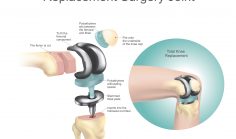A combination of treatment options can help you keep your Crohn’s under control, and help you lead a full and rewarding life. While there is no one standard treatment for Crohn’s, your doctor will work with you to find the right course of therapies for your particular case. Treatment for Crohn’s can include:
- Medication
- Alterations in diet and nutrition
- Surgical procedures to repair or remove affected portions of your intestinal tract
MEDICATION
Medication treating Crohn’s disease is designed to suppress your immune system’s abnormal inflammatory response that is causing your symptoms. Suppressing inflammation not only offers relief from common symptoms like fever, diarrhea, and pain, it also allows your intestinal tissues to heal.
In addition to controlling and suppressing symptoms (inducing remission), medication can also be used to decrease the frequency of symptom flare-ups (maintaining remission). With proper treatment over time, periods of remission can be extended and periods of symptom flare-ups can be reduced.
Several types of medication are being used to treat Crohn’s disease today. Some over-the-counter medications may help relieve symptoms of Crohn’s, but always speak with your doctor before taking any over-the-counter medications. Depending on the severity of your Crohn’s disease, your doctor may recommend one or more of the following:
- Anti-diarrheals.A fiber supplement, such as psyllium powder (Metamucil) or methylcellulose (Citrucel), can help relieve mild to moderate diarrhea by adding bulk to your stool. For more severe diarrhea, loperamide (Imodium) may be effective. Anti-diarrheals should only be used after discussion with your doctor.
- Pain relievers.For mild pain relief, your doctor may recommend acetaminophen (Tylenol, others) — but not other common pain relievers, like ibuprofen (Advil, Motrin, others), naproxen sodium (Aleve, Anaprox). These drugs are likely to make your symptoms worse, and can therefore negatively impact disease outcomes.
- Iron supplements. Chronic intestinal bleeding may lead to iron deficiency anemia, if this is the case, you may need to take iron supplements.
Medications for mild to moderate Crohn’s:
Antibiotics. There is some evidence suggesting that antibiotics like metronidazole, ciproflaxin, and flagyll may be helpful in treating mild to moderate cases of Crohn’s disease. Metronidazole is the most extensively studied antibiotic in IBD (irritable bowel disease, which is a category of diseases affecting the bowel that includes Crohn’s disease). As a primary therapy for active Crohn’s, this drug has been shown to be superior to placebo (sugar pill) and equal to sulfasalazine—especially when the illness affects the colon. Antibiotics can help stop infections and heal abscesses and fistulas that happen because of Crohn’s disease.
Side effects of use of antibiotics for Crohn’s treatment may include:
- Metronidazole: Chronic use of metronidazole in doses higher than 1 gram daily can be associated with permanent nerve damage (peripheral neuropathy). Early symptoms of peripheral neuropathy are numbness and tingling in the fingertips, toes, and other parts of the extremities. Patients taking this medication need to avoid alcohol as the combination of the two can cause headache, cramping, vomiting, severe nausea, and more. Other side effects of metronidazole include nausea, headaches,loss of appetite, a metallic taste, and, rarely, a rash.
- Ciprofloxacin: Side effects may include headaches, nausea, vomiting, diarrhea, abdominal pain, rash, and restlessness, all of which are rare.
5-Aminosalicylates (5-ASAs). 5-ASAs are a class of anti-inflammatory drugs that are thought to work as a topical anti-inflammatory for the GI tract. 5-aminosalicylic acid (5-ASA), is also called mesalamine. 5-ASA can be effective in treating Crohn’s disease and ulcerative colitis, which is the other condition included in the category of IBD. if the drug can be delivered topically onto the inflamed intestinal lining. For example, mesalamine (Rowasa) is an enema containing 5-ASA that is effective in treating inflammation in the rectum. However, the enema solution cannot reach high enough to treat inflammation in the upper colon and the small intestine.
Side effects of 5-Aminosalicyclates may include:
- This class of medications has a few side effects which may include nausea,heartburn, headache, anemia, skin rashes, and, in rare instances, hepatitis and kidney inflammation. In men, sulfasalazine can reduce the sperm count. The reduction in sperm count is reversible, and the count usually becomes normal after the sulfasalazine is discontinued or changed to a different 5- ASA compound. They can have a burdensome pill count (anywhere from 4-12 each day.
Common 5-ASAs include:
- Sulfasalazine (Azufadine), which is one of the longest running drugs on the market for treating irritable bowel disorders. Though it has been used for decades, about 1 in 3 people are unable to sustain sulfasalazine use long-term due to severe side effects. The majority of people who react to sulfasalazine can, however, tolerate the other 5-ASAs, like: Asacol; Asacol HD; Apriso; Lialda
Patients taking 5-ASAs should have regular blood and liver tests to check for potential low cell count and liver complications. Side effects may include abdominal pain, headache, dizziness, and nausea.
Medications for moderate to severe Crohn’s:
Corticosteroids. Have been used for many years to treat patients with moderate to severe Crohn’s disease and ulcerative colitis and to treat patients who fail to respond to 5-ASA. Unlike 5-ASA, corticosteroids do not require direct contact with the inflamed intestinal tissues to be effective. Corticosteroids are anti-inflammatory and immunosuppressant, meaning that they reduce inflammation and work to suppress the immune system. When antibiotics and 5-ASAs fail to treat Crohn’s symptoms successfully, corticosteroids are the next-in-line drug. Corticosteroids are faster-acting than 5-ASA, and patients frequently experience improvement in their symptoms within days of beginning them. Corticosteroids, however, do not appear to be useful in maintaining remission in Crohn’s disease and ulcerative colitis or in preventing the return of Crohn’s disease after surgery. Corticosteroids may be administered in pill form, by intravenous drip (IV), as an enema, or as a rectal suppository. Caution should be used in their prescription because of the risk of the body becoming steroid-dependent.
These include:
Prednisone is one of the most commonly prescribed steroids, and is known to cause remissions in 70-80% of patients. It is not effective for long-term treatment.
Specific side effects of Prednisone may include:
- osteoporosis, diabetes, depression, high blood pressure, and adrenal conditions. As well, headaches, nausea, vomiting, diarrhea, abdominal pain, rash, and restlessness, all of which are rare.
Budesonide is another corticosteroid that was created with the goal of having fewer side effects than prednisone and other corticosteroids. Instead of travelling throughout the whole body, budesonide is released only in the end of the small intestine and ascending colon, limiting its affects to those areas. This prevents more widespread side effects, but limits its use to only patients who have Crohn’s inflammation in those areas.
Side effects of budesonide may include:
- headache, dizziness, and nausea.
The frequency and severity of side effects of corticosteroids depend on the dose and duration of their use. Short courses of corticosteroids, for example, usually are well tolerated with few and mild side effects. Long-term use of high doses of corticosteroids usually produces predictable and potentially serious side effects. Children need to be especially careful with use of corticosteroids as they can stunt growth.
Common side effects of corticosteroids in general include:
- Rounding of the face, sometimes referred to as “moon face”
- Acne
- Growth of excess body hair
- Weight gain
- Weakened muscles
- High blood pressure
- Diabetes
- Cataracts
- Glaucoma
- Irritability and increased mood swings
- Depression
- Osteopenia or osteoporosis—a thinning of the bones that can lead to increased risk of fracture
Prolonged use of corticosteroids can cause adrenal insufficiency, a condition where the adrenal glands are not able to produce as much cortisol—necessary for proper functioning of the body. Cortisol helps the body manage stress, infections and other functions. Symptoms of adrenal insufficiency include nausea, vomiting, and even shock. Withdrawing corticosteroids too quickly also can produce symptoms of fever, fatigue, and joint pain. Therefore, when corticosteroids are discontinued, the dose usually is tapered gradually rather than stopped abruptly. It is important to note that even after stopping corticosteroid use, the adrenal glands may continue to be produce less cortisol, which can last for several months up to two years.
Long-term use of corticosteroids can lead to osteopenia or osteoporosis—therefore increasing dietary calcium, along with a calcium supplement is important. It is also important to do regular weight-bearing exercise and not smoke.
Corticosteroids, while very effective, have predictable and potentially serious side effects, and should be used for the shortest possible length of time.
Immunosuppressants, also called immunomodulators or immune modifiers, are medications that affect the immune system—the body’s defense against harmful viruses, bacteria and other foreign invaders. When the immune system is activated, it causes inflammation where the activation occurs—part of the defensive response. Normally, activation only occurs when the body is exposed to foreign invaders, but in patients with Crohn’s, the immune system goes into over-drive and is chronically activated even when there is not invader. This class of drugs works to block actions in the immune system that are involved with the inflammatory response. Immunosuppresants work to decrease inflammation by reducing the number of immune cells—this can increase risk of infection, but can have great benefit in controlling moderate to severe Crohn’s.
Common immunosuppressants include:
- Azathioprine (AZA). AZA is taken orally, and typically takes 6 to 12 weeks to take full effect. 2 out of 3 patients experience relief from Crohn’s flare-ups. With limited side effects, AZA is an effective treatment, though it can put patients at higher risk of infection and lymphoma; and 2% may be allergic. Regular blood tests can help detect any potentially serious side effects.
- Methotrexate (MTX). MTX is administered via weekly injection, and typically takes around 6 weeks to take effect. Like AZA, MTX is successful in preventing Crohn’s flare-ups in 2 out of 3 patients. Patients taking MTX should undergo regular blood testing to monitor potential side effects like low cell counts or liver damage. It is recommended to take a folic acid supplement when undergoing treatment with MTX as it can deplete essential fatty acid. MTX should NOT be taken by pregnant women or those looking to conceive.
Medications for severe or fulminate Crohn’s:
Anti-tumor necrosis factor-alpha (Anti-TNF-α). This type of drug works by using antibodies targeted at TNF-α, an inflammatory protein that has been found in high levels in Crohn’s disease patients, and decreases inflammation by blocking tumor necrosis factor (TNF-alpha). 1 out of 3 patients report symptom improvement within the first two doses, around 2-3 weeks. 30-50% of patients continue their success past the one-year mark, and 30-50% will need to change their medication or anti-TNF-α dosage at some point during their therapy. Anti-TNF factors put patients at a slightly higher risk of serious heart disease, autoimmune conditions, and liver disease.
- Infliximab is used in cases of severe Crohn’s disease, where symptoms do not respond to any other therapies. While effective, it can lose efficacy over time. Given through an IV, for a two to three hour session, and is given again two to six weeks later. After the first three doses, infliximab is given every 8 weeks. It has proven to be very effective, though it can lose its effectiveness over time in some patients. Infliximab is given via an intravenous drip (IV) during a two to three hour session. Follow up doses are given two and six weeks later. Following the initial 3 doses, the medication is administered every 8 weeks. In August 1998 the United States Food and Drug Administration approved the use of infliximab for the short-term treatment of moderate to severe Crohn’s disease, for patients that fail to respond to other treatments.
- Adalamumab (Humira). Adalamumab is used in cases of severe Crohn’s disease, where symptoms do not respond to any other therapies, or in cases where patients have lost responsiveness to Infliximab. Adalamumab is given in a single injection every other week, after an initial four injections in the first week of treatment. Two injections are then given in week 3. It has proven to be very effective, though it can lose its effectiveness over time in some patients—which may be partly mitigated by upping dosage to weekly injections. Adalimumab is comparable to infliximab in effectiveness and safety for inducing and maintaining remission in patients suffering from Crohn’s disease. Adalimumab generally is well tolerated.
- Certolizumab pegol (Cimzia). Certolizumab pegol is a prolonged effect anti TNF agent, and only needs to be administered once monthly by a healthcare professional, often done at a doctor’s office.
- Natalizumab (Tysabri). Natalizumab was originally created as a treatment for multiple sclerosis, but was found to be effective in treating Crohn’s disease in 2008.
Specific side effects of Adalamumab may include:
- The most common side effect is skin reactions at the site of injection with swelling,itching, or redness. Other common side effects include upper respiratory infections, sinusitis, and nausea. The Food and Drug Administration approved Humira (adalimumab) in February 2007, to treat adult patients with moderately to severely active Crohn’s disease. Adalimumab (Humira) is administered subcutaneously every two weeks.
Specific side effects of natalizumab may include:
- A significant risk to use of this drug for Crohn’s is risk of developing progressive multifocal leukoencephalopathy, or PML, a potentially deadly brain infection. Risk of developing PML is 1 in 1,000. The good news is that doctors are better able to control the risk of PML today than when the drug was first introduced.
DIET & NUTRITION
While Crohn’s Disease may not be the result of bad reactions to specific foods, paying special attention to your diet may help reduce symptoms, replace lost nutrients, and promote healing.
For people diagnosed with Crohn’s disease, it is essential to maintain good nutrition because Crohn’s often reduces your appetite while increasing your body’s energy needs. Additionally, common Crohn’s symptoms like diarrhea can reduce your body’s ability to absorb protein, fat, carbohydrates, as well as water, vitamins, and minerals.
Many people who experience Crohn’s disease flare-ups find that soft, bland foods cause less discomfort than spicy or high-fiber foods. While your diet can remain flexible and should include a variety of foods from all food groups, your doctor will likely recommend restricting your intake of dairy if you are found to be lactose-intolerant.
Diet and Nutritional Therapy for Crohn’s:
Nutritional therapy is a crucial part of Crohn’s treatment—especially in children—because inflammation of the intestines can impede absorption of nutrients, and can cause deficiencies. The Crohn’s and Colitis Foundation of America states that supplements like vitamins and minerals should be used only in addition to conventional medical treatment. Registered nutritionists or dietitians can help you put together a diet and supplement plan that ensures proper nutrition and improves digestive symptoms.
In certain cases, it may be recommended that you go on a special diet given via feeding tube, or have nutrients directly injected into your body to treat a particularly severe case of Crohn’s. This can improve health by allowing the bowel to rest and heal. This is also sometimes done prior to surgery or when other medications fail to control symptoms.
If you have a narrowed bowel, also known as a stricture, your doctor may suggest a low-fiber (sometimes called a low-residue diet) diet to reduce risk of intestinal blockage by reducing size and number of your stools.
Vitamin and mineral deficiencies are among the most common nutritional deficits that Crohn’s patients suffer. Your doctor or dietitian many recommend the following supplements:
- Vitamin B-12. Vitamin B-12 is essential to brain and nervous function, and can naturally be found in eggs, fish such as salmon, beef, shellfish, liver, and fortified soy and dairy products. Sometimes B12 injections are administered if blood work shows a deficiency. Vegetarians and vegans must pay closer attention to B12 deficiency.
- Vitamin D. Vitamin D is essential for good bone formation and for the metabolism of calcium, and deficiency can be common in those with Crohn’s disease.
- Calcium. Calcium helps fortify bones and promotes healthy muscle and nerve function, certain Crohn’s medications can also negatively impact bone health, particularly with long-term corticosteroid use.
- Iron. Iron is essential to energy and well-being, as well as protein production in the body. Lack of iron can lead to anemia, which can cause fatigue. Iron is found in beef, fish, poultry, pumpkin seeds, spinach, cooked beans, tofu, and wheat germ among many other foods. Iron deficiency can result from blood loss following intestinal inflammation and ulceration typical of Crohn’s
- Probiotic supplement. Probiotics help replenish healthy bacteria, because of the inflammation associated with Crohn’s disease; the population of healthy gut bacteria is often decreased. Lactobacillus and bifid bacteria are the most common types of bacteria found in probiotic supplements.
In addition to recommending the proper supplements, your dietitian will be able to help you build a diet plan that avoids foods that exacerbate your Crohn’s symptoms. Typical inflammatory foods that you may want to avoid include:
- Alcoholic beverages (including mixed drinks, wine and beer)
- Foods high in fat such as butter, oil, mayonnaise, and fried foods
- Caffeinated beverages (including coffee, tea, energy drinks)
- Chocolate
- Spicy foods
- Raw fruits and vegetables
- Foods high in fiber such as whole grains and beans
- Nuts, nut butters, and seeds
Nutritional therapy can be a critical part of treatment no matter what stage of your condition is in. Make sure that your doctor and dietitian are in communication about what supplements you are taking in order to avoid medication interference.
SURGERY
Even with proper medication and diet, as many as two-thirds to three-quarters of people with Crohn’s disease will require surgery at some point during their lives. While surgery does not cure Crohn’s disease, it can conserve portions of your GI tract and return you to the best possible quality of life.
Surgery becomes necessary when medications can no longer control symptoms, or if you develop a fistula, fissure, or intestinal obstruction. Surgery often involves removal of the diseased segment of bowel (resection); the two ends of healthy bowel are then joined together (anastomosis). While these procedures may cause your symptoms to disappear for many years, Crohn’s frequently recurs later in life.
Crohn’s surgical procedures:
Your doctor may recommend surgery if other forms of therapy if symptoms have not responded to medications, diet and lifestyle modifications, and other therapies. Up to one-half of individuals with Crohn’s disease will require at least one surgery—but it is important to note that surgery does not cure Crohn’s disease.
During surgery, your surgeon may:
- Perform a strictureplasty—a common procedure for Crohn’s disease that widens a segment of the intestine that has become too narrow.
- Bowel resection—this procedure involves removing a damaged portion of your digestive tract, and then reconnecting the healthy sections. This is usually successful in reducing symptoms almost immediately; however 50% of patients see symptoms return within 5 years, and 20% will require additional surgeries within 10 years.
- Proctocolectomy and Ostomy. Used only in the most severe Crohn’s disease cases where the entire colon is affected, a proctocolectomy, or total removal of the colon, may be necessary. After the colon is removed, surgeons redirect waste through the small intestine to a hole in the abdominal wall known as a stoma. Waste then collects in a bag outside of the body, called a colostomy bag, which needs to be emptied several times a day. This is a major surgery that has life-changing implications, but is shown to effectively eliminate all Crohn’s disease symptoms in cases where inflammation was limited to the colon.
- Surgery may also be used to close fistulas and drain abscesses.
The benefits of surgery for Crohn’s disease are usually temporary. The disease often recurs, frequently near the reconnected tissue. Following surgery with medication can help minimize risk of recurrence.













